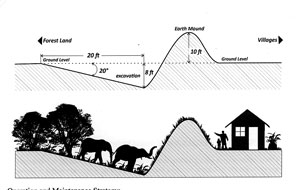Sunday Times 2
Elephant barrier trenching fails due to faulty structural design
On Dec 12, 2021, this paper carried an article titled ‘Trenches against wild elephants – tried and failed – say experts’. In that article, the trenching system to mitigate elephant intrusion into areas of human habitation has been projected as a failure by the recently appointed Expert Panel who conducted a pilot project to assess its feasibility.
 I was seemingly the first to bring up this suggestion six years ago in my article in the Daily Mirror on July 19, 2016, still accessible over the internet (‘A Permanent Solution to the Man-Elephant Conflict by Charles de Silva’ ) where I gave a detailed explanation with figures and sketches, along with presumably appropriate parametres that have to be taken into account in the structuring of my proposed ‘trench and mound’ elephant barrier which I referred to as ‘slider bank system’. I did not mean just cutting trenches as is being done now.
I was seemingly the first to bring up this suggestion six years ago in my article in the Daily Mirror on July 19, 2016, still accessible over the internet (‘A Permanent Solution to the Man-Elephant Conflict by Charles de Silva’ ) where I gave a detailed explanation with figures and sketches, along with presumably appropriate parametres that have to be taken into account in the structuring of my proposed ‘trench and mound’ elephant barrier which I referred to as ‘slider bank system’. I did not mean just cutting trenches as is being done now.
The newly-appointed expert panel’s assessed main failure in the elephant barrier trenching system is that they haven’t followed the proper layout of the trenching system. The article had displayed a photograph of a trench ditched purportedly as per the instructions of the panel, which says it all. That type of trenching is bound to fail. The frail edges of that trench would collapse easily with the weight of the elephants reaching the trench or intentionally breached by them, making the purpose of the trench redundant. Conversely, my proposed ‘trench and mound’ system will have a broader stretch of sliding ground running to the extent of 20ft at a specific declining angle of 20 degrees, sliding down up to the deepest end of the excavation where it would attain a depth of 8ft (approx). The entire mass of the earth so gathered by the excavation has to be heaped on the bank opposite the trench at an optimally steep elevation so the height of the mound and the depth of the trench together would create a complementing height of 18ft (approx) which the elephants find difficult to climb. The embankment should be well reinforced so that it stays firm and unbreachable, and that it may not be washed away by rain. The earth recovered by excavating the trench, has to constitute an integral part of the barrier and not be given away or sold. An accompanying article that appeared on the same page of the recent article, titled ‘Dig the Trench and take the Soil’, expressed the availability of an invitation to the public to dig the trench and take away the earth as a payoff. Giving away the excavated earth is contrary to the system I’m advocating since the excavated earth would have to be made to constitute an essential part of the ‘trench-and-mound’ barrier.
Authoritative sources reveal that over 4,000 workers are now being deployed and huge amounts of money being spent to build, maintain and look-after the now defunct electric fence which is involved with excessive timber-felling. The currently deployed workforce could then be made to look after and maintain the embankment, allotting segments of around 1 km to each individual. This could also be operated as a community development project by getting the residents of the respective areas to be employed for the purpose. Commercial establishments could also be invited to build and/or maintain segments of the barrier in populated areas and those that run alongside public roads and highways and utilise the allotted sections to display and advertise their products and wares. This ‘trench-and-mound’ system can be made operative in areas where it’s feasible, while other areas where we have rocky and drenched land can be covered by conventional methods which are being used hitherto, or with other appropriate methods. The initial cost of construction of the proposed system may be appreciable vis-à-vis the cost of erecting the electric fence. However, its maintenance cost and recurrent expenses would be far less and hence would be economically advantageous in the long-run while protecting the valuable forest resources being plundered.
It’s my hope that the authorities concerned would pilot a sample segment of this proposed ‘trench-and-mound’ barrier system and assess its viability and efficacy and decide whether this system would be a success. If it proves to be of any help towards mitigating the yet unsolved human-elephant conflict, it would help save many a life, while also protecting the valuable cultivations and hard-earned assets of innocent peasants.

